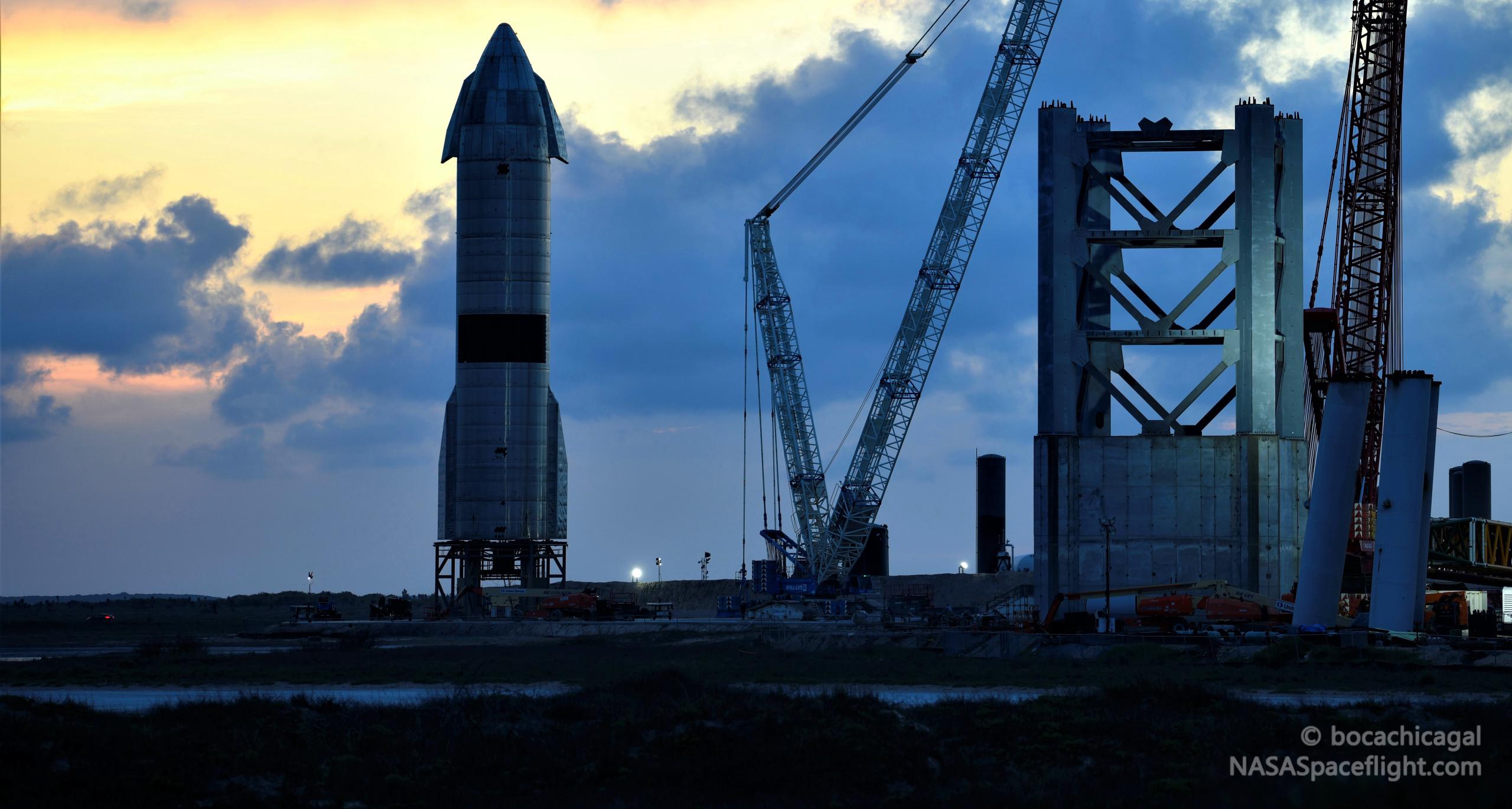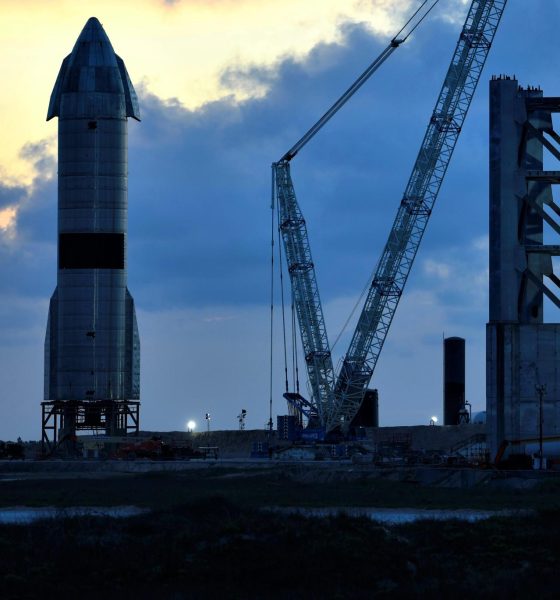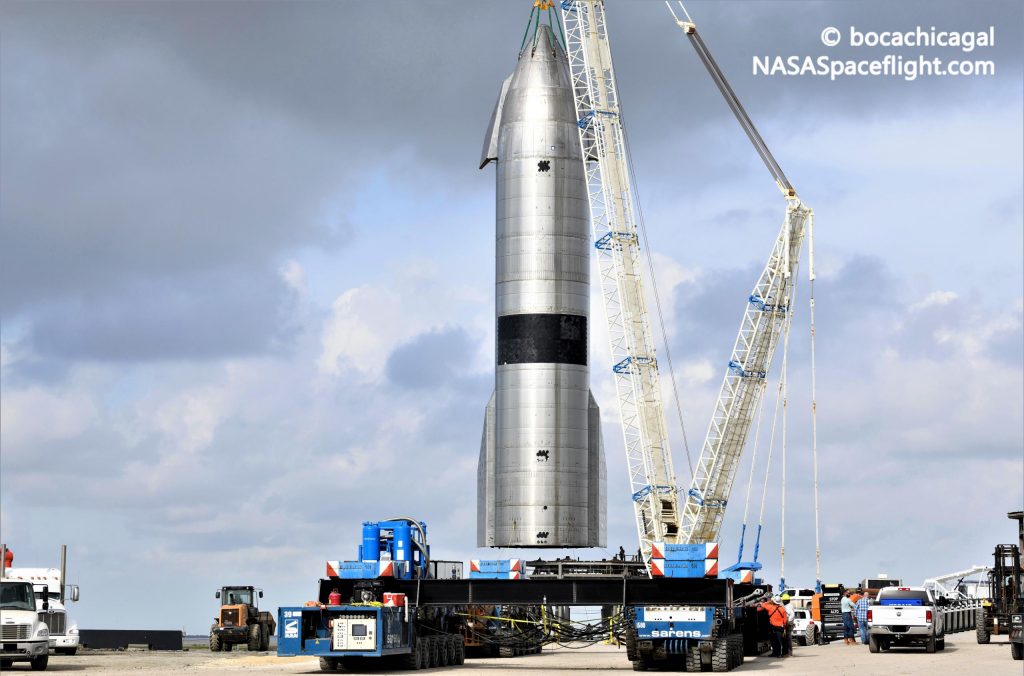

News
SpaceX’s first flight-proven Starship takes another step towards reuse
Nine days after becoming the first full-size prototype to survive a high-altitude launch and landing, SpaceX has installed Starship SN15 at the second of two identical launch mounts to prepare for potential reuse.
On May 5th, after a week or two of several minor delays, Starship SN15 – the fifth full-size prototype of its kind – lifted off from SpaceX’s Boca Chica, Texas launch pad under the thrust of three Raptor engines. Like all four of its predecessors, the 50-meter-tall (165 ft) steel rocket easily ascended to an apogee greater than 10 km (6.2 mi), shutting down one Raptor every ~90 seconds to its keep velocity low. When the final engine cut off, SN15 arced over onto its belly and free-fell to around half a kilometer above the ground, using four hollow steel ‘flaps’ to control its orientation like a skydiver’s limbs.
The most radical maneuver came around six minutes after liftoff when the sideways Starship reignited two or three of its Raptors, aggressively flipped into a nose-up position, deployed six stubby landing legs, and gently touched down a few hundred feet east of the stand it took off from.
Despite a fairly large fire that burned for several minutes after touchdown, SpaceX ultimately found itself – for the first time ever – with a full-size Starship prototype that survived its inaugural ~10-km launch and landing. A careful process of safing and securing then followed as operators commanded (or monitored) SN15 to disarm explosive flight termination system (FTS) charges, vent any remaining propellant, and eventually depressurize its fuel and oxygen tanks.
Unlike Starhopper, SN5, and SN6 – which also survived flights – SpaceX was apparently able to safe SN15 without any real issues and recovery teams were able to approach the rocket within a few hours of landing instead of the 12-24+ hours that were normal prior. SpaceX also debuted a sort of supersized version of the ‘Octagrabber’ robots that remotely secure Falcon boosters after drone ship landings, allowing the recovery team to secure Starship SN15 to a stable platform and transporter without a crane.
No longer at risk of toppling over, Starship SN15 then… sat where it landed. Less than two days after touchdown, CEO Elon Musk unexpectedly revealed that SpaceX “might try to refly SN15 soon,” indicating that initial post-flight inspections had revealed that the first flight-proven three-engine Starship was in excellent condition. SN15 would ultimately spend another four days (six total) sitting on a transporter at the landing zone. On May 11th, SpaceX rolled Starship SN15 from its landing spot to “Pad B” – the second of two identical suborbital launch mounts.


Perhaps due to stormy weather and high wind gusts in the area, SN15 once again sat still – this time for another three days. Ultimately, the Starship prototype was rapidly lifted onto Pad B’s launch mount, secured, and detached from the crane in a matter of hours of May 14th – possibly the smoothest pad installation yet. In the two days since then, SpaceX has begun more in-depth inspections that will ultimately determine whether the first flight-proven Starship is truly fit for a second launch.
That process likely wont take more than a few days and even if SN15 isn’t deemed (re)flightworthy, there’s still a very good chance SpaceX will put the Starship through some kind of test(s) before it’s retired. Stay tuned for more details likely to come this week.

Elon Musk
Elon Musk and Tesla AI Director share insights after empty driver seat Robotaxi rides
The executives’ unoccupied tests hint at the rapid progress of Tesla’s unsupervised Robotaxi efforts.

Tesla CEO Elon Musk and AI Director Ashok Elluswamy celebrated Christmas Eve by sharing personal experiences with Robotaxi vehicles that had no safety monitor or occupant in the driver’s seat. Musk described the system’s “perfect driving” around Austin, while Elluswamy posted video from the back seat, calling it “an amazing experience.”
The executives’ unoccupied tests hint at the rapid progress of Tesla’s unsupervised Robotaxi efforts.
Elon and Ashok’s firsthand Robotaxi insights
Prior to Musk and the Tesla AI Director’s posts, sightings of unmanned Teslas navigating public roads were widely shared on social media. One such vehicle was spotted in Austin, Texas, which Elon Musk acknowleged by stating that “Testing is underway with no occupants in the car.”
Based on his Christmas Eve post, Musk seemed to have tested an unmanned Tesla himself. “A Tesla with no safety monitor in the car and me sitting in the passenger seat took me all around Austin on Sunday with perfect driving,” Musk wrote in his post.
Elluswamy responded with a 2-minute video showing himself in the rear of an unmanned Tesla. The video featured the vehicle’s empty front seats, as well as its smooth handling through real-world traffic. He captioned his video with the words, “It’s an amazing experience!”
Towards Unsupervised operations
During an xAI Hackathon earlier this month, Elon Musk mentioned that Tesla owed be removing Safety Monitors from its Robotaxis in Austin in just three weeks. “Unsupervised is pretty much solved at this point. So there will be Tesla Robotaxis operating in Austin with no one in them. Not even anyone in the passenger seat in about three weeks,” he said. Musk echoed similar estimates at the 2025 Annual Shareholder Meeting and the Q3 2025 earnings call.
Considering the insights that were posted Musk and Elluswamy, it does appear that Tesla is working hard towards operating its Robotaxis with no safety monitors. This is quite impressive considering that the service was launched just earlier this year.
Elon Musk
Starlink passes 9 million active customers just weeks after hitting 8 million
The milestone highlights the accelerating growth of Starlink, which has now been adding over 20,000 new users per day.

SpaceX’s Starlink satellite internet service has continued its rapid global expansion, surpassing 9 million active customers just weeks after crossing the 8 million mark.
The milestone highlights the accelerating growth of Starlink, which has now been adding over 20,000 new users per day.
9 million customers
In a post on X, SpaceX stated that Starlink now serves over 9 million active users across 155 countries, territories, and markets. The company reached 8 million customers in early November, meaning it added roughly 1 million subscribers in under seven weeks, or about 21,275 new users on average per day.
“Starlink is connecting more than 9M active customers with high-speed internet across 155 countries, territories, and many other markets,” Starlink wrote in a post on its official X account. SpaceX President Gwynne Shotwell also celebrated the milestone on X. “A huge thank you to all of our customers and congrats to the Starlink team for such an incredible product,” she wrote.
That growth rate reflects both rising demand for broadband in underserved regions and Starlink’s expanding satellite constellation, which now includes more than 9,000 low-Earth-orbit satellites designed to deliver high-speed, low-latency internet worldwide.
Starlink’s momentum
Starlink’s momentum has been building up. SpaceX reported 4.6 million Starlink customers in December 2024, followed by 7 million by August 2025, and 8 million customers in November. Independent data also suggests Starlink usage is rising sharply, with Cloudflare reporting that global web traffic from Starlink users more than doubled in 2025, as noted in an Insider report.
Starlink’s momentum is increasingly tied to SpaceX’s broader financial outlook. Elon Musk has said the satellite network is “by far” the company’s largest revenue driver, and reports suggest SpaceX may be positioning itself for an initial public offering as soon as next year, with valuations estimated as high as $1.5 trillion. Musk has also suggested in the past that Starlink could have its own IPO in the future.
News
NVIDIA Director of Robotics: Tesla FSD v14 is the first AI to pass the “Physical Turing Test”
After testing FSD v14, Fan stated that his experience with FSD felt magical at first, but it soon started to feel like a routine.

NVIDIA Director of Robotics Jim Fan has praised Tesla’s Full Self-Driving (Supervised) v14 as the first AI to pass what he described as a “Physical Turing Test.”
After testing FSD v14, Fan stated that his experience with FSD felt magical at first, but it soon started to feel like a routine. And just like smartphones today, removing it now would “actively hurt.”
Jim Fan’s hands-on FSD v14 impressions
Fan, a leading researcher in embodied AI who is currently solving Physical AI at NVIDIA and spearheading the company’s Project GR00T initiative, noted that he actually was late to the Tesla game. He was, however, one of the first to try out FSD v14.
“I was very late to own a Tesla but among the earliest to try out FSD v14. It’s perhaps the first time I experience an AI that passes the Physical Turing Test: after a long day at work, you press a button, lay back, and couldn’t tell if a neural net or a human drove you home,” Fan wrote in a post on X.
Fan added: “Despite knowing exactly how robot learning works, I still find it magical watching the steering wheel turn by itself. First it feels surreal, next it becomes routine. Then, like the smartphone, taking it away actively hurts. This is how humanity gets rewired and glued to god-like technologies.”
The Physical Turing Test
The original Turing Test was conceived by Alan Turing in 1950, and it was aimed at determining if a machine could exhibit behavior that is equivalent to or indistinguishable from a human. By focusing on text-based conversations, the original Turing Test set a high bar for natural language processing and machine learning.
This test has been passed by today’s large language models. However, the capability to converse in a humanlike manner is a completely different challenge from performing real-world problem-solving or physical interactions. Thus, Fan introduced the Physical Turing Test, which challenges AI systems to demonstrate intelligence through physical actions.
Based on Fan’s comments, Tesla has demonstrated these intelligent physical actions with FSD v14. Elon Musk agreed with the NVIDIA executive, stating in a post on X that with FSD v14, “you can sense the sentience maturing.” Musk also praised Tesla AI, calling it the best “real-world AI” today.








